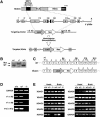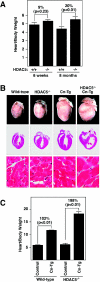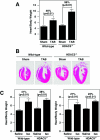Histone deacetylases 5 and 9 govern responsiveness of the heart to a subset of stress signals and play redundant roles in heart development
- PMID: 15367668
- PMCID: PMC516756
- DOI: 10.1128/MCB.24.19.8467-8476.2004
Histone deacetylases 5 and 9 govern responsiveness of the heart to a subset of stress signals and play redundant roles in heart development
Abstract
The adult heart responds to stress signals by hypertrophic growth, which is often accompanied by activation of a fetal cardiac gene program and eventual cardiac demise. We showed previously that histone deacetylase 9 (HDAC9) acts as a suppressor of cardiac hypertrophy and that mice lacking HDAC9 are sensitized to cardiac stress signals. Here we report that mice lacking HDAC5 display a similar cardiac phenotype and develop profoundly enlarged hearts in response to pressure overload resulting from aortic constriction or constitutive cardiac activation of calcineurin, a transducer of cardiac stress signals. In contrast, mice lacking either HDAC5 or HDAC9 show a hypertrophic response to chronic beta-adrenergic stimulation identical to that of wild-type littermates, suggesting that these HDACs modulate a specific subset of cardiac stress response pathways. We also show that compound mutant mice lacking both HDAC5 and HDAC9 show a propensity for lethal ventricular septal defects and thin-walled myocardium. These findings reveal central roles for HDACs 5 and 9 in the suppression of a subset of cardiac stress signals as well as redundant functions in the control of cardiac development.
Figures







Similar articles
-
Dual roles of histone deacetylases in the control of cardiac growth.Novartis Found Symp. 2004;259:132-41; discussion 141-5, 163-9. Novartis Found Symp. 2004. PMID: 15171251 Review.
-
Class II histone deacetylases act as signal-responsive repressors of cardiac hypertrophy.Cell. 2002 Aug 23;110(4):479-88. doi: 10.1016/s0092-8674(02)00861-9. Cell. 2002. PMID: 12202037 Free PMC article.
-
The transcriptional coactivator CAMTA2 stimulates cardiac growth by opposing class II histone deacetylases.Cell. 2006 May 5;125(3):453-66. doi: 10.1016/j.cell.2006.02.048. Cell. 2006. PMID: 16678093
-
Targeted disruption of Hspa4 gene leads to cardiac hypertrophy and fibrosis.J Mol Cell Cardiol. 2012 Oct;53(4):459-68. doi: 10.1016/j.yjmcc.2012.07.014. Epub 2012 Aug 1. J Mol Cell Cardiol. 2012. PMID: 22884543
-
Control of cardiac hypertrophy and heart failure by histone acetylation/deacetylation.Novartis Found Symp. 2006;274:3-12; discussion 13-9, 152-5, 272-6. Novartis Found Symp. 2006. PMID: 17019803 Review.
Cited by
-
Histone deacetylases in modulating cardiac disease and their clinical translational and therapeutic implications.Exp Biol Med (Maywood). 2021 Jan;246(2):213-225. doi: 10.1177/1535370220944128. Epub 2020 Jul 29. Exp Biol Med (Maywood). 2021. PMID: 32727215 Free PMC article. Review.
-
Mutagenesis Study Reveals the Rim of Catalytic Entry Site of HDAC4 and -5 as the Major Binding Surface of SMRT Corepressor.PLoS One. 2015 Jul 10;10(7):e0132680. doi: 10.1371/journal.pone.0132680. eCollection 2015. PLoS One. 2015. PMID: 26161557 Free PMC article.
-
Histone deacetylases as targets for the treatment of human neurodegenerative diseases.Drug News Perspect. 2009 Nov;22(9):513-24. doi: 10.1358/dnp.2009.9.1428871. Drug News Perspect. 2009. PMID: 20072728 Free PMC article. Review.
-
Identification of novel hypermethylated or hypomethylated CpG sites and genes associated with anthracycline-induced cardiomyopathy.Sci Rep. 2023 Aug 4;13(1):12683. doi: 10.1038/s41598-023-39357-2. Sci Rep. 2023. PMID: 37542143 Free PMC article.
-
Control of endothelial cell proliferation and migration by VEGF signaling to histone deacetylase 7.Proc Natl Acad Sci U S A. 2008 Jun 3;105(22):7738-43. doi: 10.1073/pnas.0802857105. Epub 2008 May 28. Proc Natl Acad Sci U S A. 2008. PMID: 18509061 Free PMC article.
References
-
- Antos, C. L., T. A. McKinsey, M. Dreitz, L. M. Hollingsworth, C. L. Zhang, K. Schreiber, H. Rindt, R. J. Gorczynski, and E. N. Olson. 2003. Dose-dependent blockade to cardiomyocyte hypertrophy by histone deacetylase inhibitors. J. Biol. Chem. 278:28930-28937. - PubMed
-
- Chien, K. R. 1999. Stress pathways and heart failure. Cell 98:555-558. - PubMed
-
- Davis, F. J., M. Gupta, B. Camoretti-Mercado, R. J. Schwartz, and M. P. Gupta. 2003. Calcium/calmodulin-dependent protein kinase activates serum response factor transcription activity by its dissociation from histone deacetylase, HDAC4. Implications in cardiac muscle gene regulation during hypertrophy. J. Biol. Chem. 278:20047-20058. - PubMed
Publication types
MeSH terms
Substances
LinkOut - more resources
Full Text Sources
Other Literature Sources
Molecular Biology Databases
